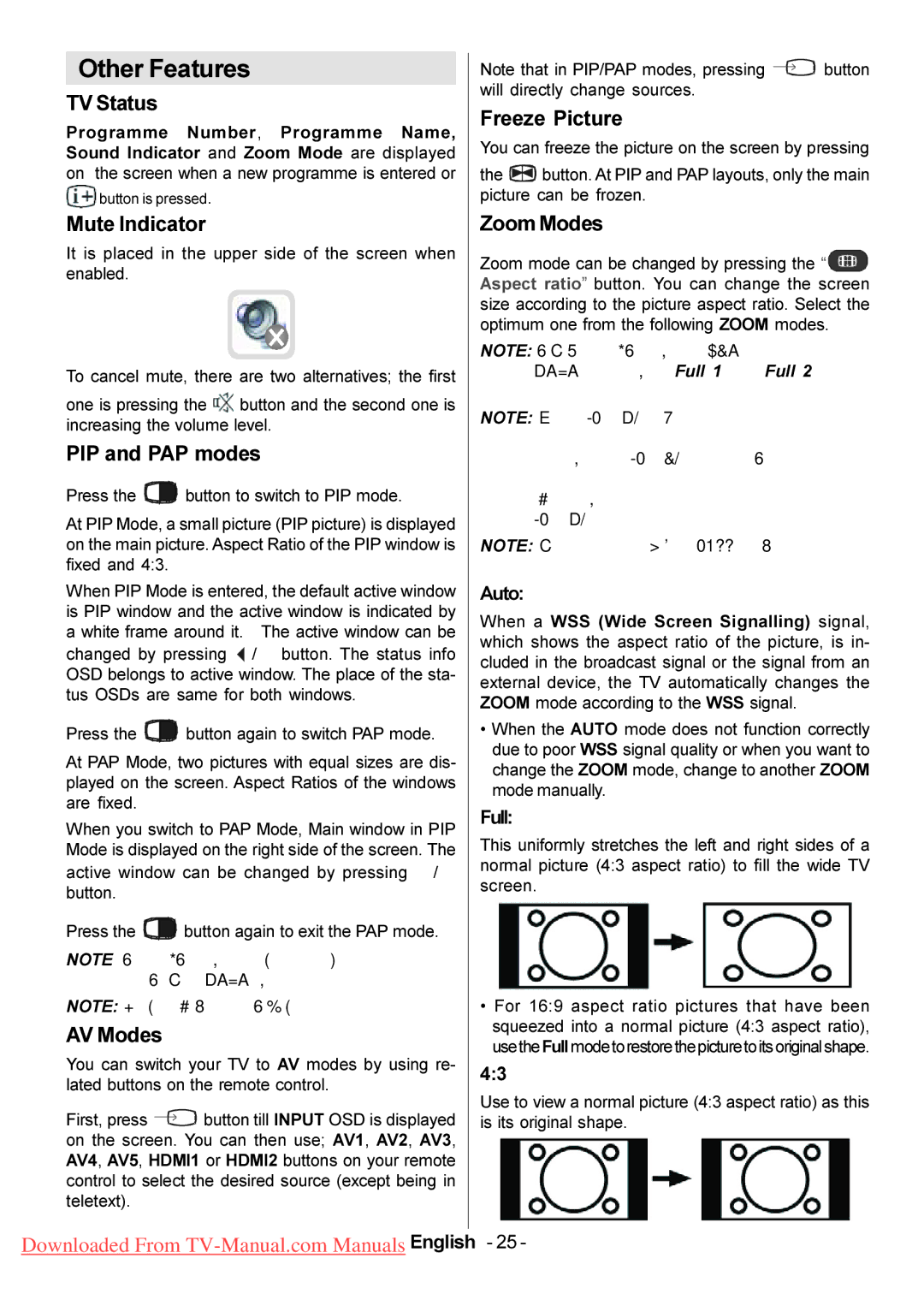
Other Features
TV Status
Programme Number, Programme Name, Sound Indicator and Zoom Mode are displayed on the screen when a new programme is entered or
![]() button is pressed.
button is pressed.
Mute Indicator
It is placed in the upper side of the screen when enabled.
To cancel mute, there are two alternatives; the first
one is pressing the ![]() button and the second one is increasing the volume level.
button and the second one is increasing the volume level.
PIP and PAP modes
Press the | button to switch to PIP mode. |
At PIP Mode, a small picture (PIP picture) is displayed on the main picture. Aspect Ratio of the PIP window is fixed and 4:3.
When PIP Mode is entered, the default active window is PIP window and the active window is indicated by a white frame around it. The active window can be changed by pressing _ / ‾ button. The status info OSD belongs to active window. The place of the sta- tus OSDs are same for both windows.
Press the | button again to switch PAP mode. |
At PAP Mode, two pictures with equal sizes are dis- played on the screen. Aspect Ratios of the windows are fixed.
When you switch to PAP Mode, Main window in PIP Mode is displayed on the right side of the screen. The active window can be changed by pressing _ / ‾ button.
Press the | button again to exit the PAP mode. |
NOTE: In all HDMI modes, Pip and PAP are not vis- ible. In YPbPr 1080i , Pip is not visible.
NOTE: See Appendix C for all PIP/PAT modes.
AV Modes
You can switch your TV to AV modes by using re- lated buttons on the remote control.
First, press ![]() button till INPUT OSD is displayed on the screen. You can then use; AV1, AV2, AV3, AV4, AV5, HDMI1 or HDMI2 buttons on your remote control to select the desired source (except being in teletext).
button till INPUT OSD is displayed on the screen. You can then use; AV1, AV2, AV3, AV4, AV5, HDMI1 or HDMI2 buttons on your remote control to select the desired source (except being in teletext).
Note that in PIP/PAP modes, pressing | button |
will directly change sources. |
|
Freeze Picture
You can freeze the picture on the screen by pressing
the ![]()
![]()
![]()
![]() button. At PIP and PAP layouts, only the main picture can be frozen.
button. At PIP and PAP layouts, only the main picture can be frozen.
Zoom Modes
Zoom mode can be changed by pressing the “![]() Aspect ratio” button. You can change the screen size according to the picture aspect ratio. Select the optimum one from the following ZOOM modes.
Aspect ratio” button. You can change the screen size according to the picture aspect ratio. Select the optimum one from the following ZOOM modes.
NOTE: InYPBPR and HDMI modes,while in 720 and 1080 resolutions, Full 1 and Full 2 modes will be visible.
NOTE: When in “Full 1” mode; if picture defects in top and bottom lines occur because of the broadcast, switch to “Full 2” mode to avoid. If such defects in the edges of picture are not experienced, it is advised that you watch in “Full 1” mode.
NOTE: You can only choose 4:3 and FULL in PC mode.
Auto:
When a WSS (Wide Screen Signalling) signal, which shows the aspect ratio of the picture, is in- cluded in the broadcast signal or the signal from an external device, the TV automatically changes the ZOOM mode according to the WSS signal.
•When the AUTO mode does not function correctly due to poor WSS signal quality or when you want to change the ZOOM mode, change to another ZOOM mode manually.
Full:
This uniformly stretches the left and right sides of a normal picture (4:3 aspect ratio) to fill the wide TV screen.
•For 16:9 aspect ratio pictures that have been squeezed into a normal picture (4:3 aspect ratio), usetheFullmodetorestorethepicturetoitsoriginalshape.
4:3
Use to view a normal picture (4:3 aspect ratio) as this is its original shape.
Downloaded From
